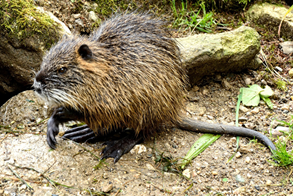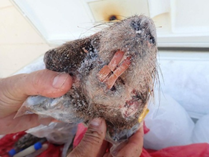 They are back!
They are back!
And this time they are huge in numbers!!
The nutria which has been especially damaging to the marshland ecology once thought to be eradicated from California is making a comeback and posing a threat to agriculture in the state, according to FERN’s latest story with KQED’s The California Report.
If you wonder about their nuisance causing habits, let me first explain you the menace they cause.
On the banks of rivers, the digging of the long burrows of the nutria often leads to destabilization and erosion of these, or an accelerated filling when it comes to ditches or canals. The network of tunnels can even, when the population is large, even weaken hydraulic structures.
Nutria feed primarily on marsh vegetation that extends above the waterline. Nutria uses their beaver-sized incisors and powerful forefeet to dig under the marsh surface to feed directly on the root mat, leaving the marsh pitted with holes causing erosion and convert healthy marsh into open water habitat. Also a favorite with corn, wheat and all kinds of vegetables, it can do considerable damage to crops if they are close to its habitat.
It destabilizes the aquatic ecosystem by over-consuming aquatic plants and destroying aquatic bird nests.
Nutria are highly prolific and breed all year. One female nutria can lead to 200 offsprings in just a year! Imagine how rapidly their population increases within a year!!
Nutria, sometimes call coypu, are hosts for several pathogens and parasites that can infect people, pets, and livestock. This rather repulsive animal may carry diseases such as leptospirosis or liver fluke.
An invasive, elusive 20-pound rodent threatens California agriculture
By Lisa Morehouse and Angela Johnston, Food & Environment Reporting Network │ December 2, 2018
 Wearing chest-high waders, biologist Sean McCain tries to tiptoe to the edge of a marsh in California’s Central Valley. A biologist with the state Department of Fish and Wildlife, McCain squints as he searches the shoreline.
Wearing chest-high waders, biologist Sean McCain tries to tiptoe to the edge of a marsh in California’s Central Valley. A biologist with the state Department of Fish and Wildlife, McCain squints as he searches the shoreline.
Sweet potato farmer Stan Silva hadn’t even heard the word “nutria” until a few months ago. He’s still never seen one, but he’s worried about the damage nutria could do if they aren’t eradicated.
“It would be devastating,” Silva says. “They can basically ruin the ag industry here — they get in your fields, burrow into your canal ways, your waterways. They’re just a menace.”
Rodents of Unusual Size Invading U.S. Wetlands
By Sarah Gibbens│ February 16, 2018
TWO HUNDRED YEARS ago, you probably wouldn’t have been able to find them outside of South America.
But since then, nutria, a giant rodent that can grow larger than 20 pounds, has taken hold in the U.S.
California is the latest region to be plagued by the large, buck-toothed, web-footed rodent. Earlier this month, the state’s fish and wildlife department issued a warning about the influx of nutria.
Breeding populations have recently taken hold in the San Joaquin Valley, just east of San Francisco.
“It’s a very frightening situation in terms of impact.”
Use of traps is not a feasible way to combat the menace caused by the nutria. Rodenticides inhibit the coagulation of blood. Thus the logistics of using traps or rodenticides is not at all a solution to this menace.
What can be an effective and efficient way to keep this nutria away from the marshlands?
We at C Tech Corporation manufacture a product CombirepelTM which is developed by using green technology. It is an extremely low concern, low toxic, low hazard and non-mutagenic animal aversive. It is durable under extreme climatic conditions.
Our product works on the mechanism of repellency. The product does not kill the target species but merely repels them.
Our product is ROHS, ROHS2, EU-BPR, ISO 9001:2000, ISO 14001:1996, APVMA, NEA complaint, and FIFRA exempted.
CombirepelTM is available in the forms of a masterbatch, liquid concentrate, and lacquer.
Masterbatch can be incorporated into polymeric applications like fencing, water pipes, irrigation tubing, agricultural films, polymeric tree guards, wires, cables, tires, agricultural equipment, etc. This would result in the final application being rodent repellent.
Liquid concentrate can be mixed in paints in a pre-determined ratio and be applied to the interior and exterior of farms, gardens, etc. to repel nutria from the area required.
Lacquer form can be directly applied to the already installed application such as farm fences, tree guards, pipes, wires, cables, etc. The lacquer is compatible with most of the surfaces like metal, wood, concrete, polymer, ceramic etc.
Hence by using CombirepelTM the farms and marshlands can be prevented from nutria damage effectively and considerably.
Contact us at technical.marketing@ctechcorporation.com if you’re facing problems with rodents and other pests and get best remedies to combat the pest menace.
Also, visit our websites:
http://www.ctechcorporation.com/
http://www.rodrepel.com/
http://www.termirepel.com/
http://www.combirepel.com/
Follow our Facebook pages at:
1] https://www.facebook.com/Combirepel-411710912249274/
2] https://www.facebook.com/Termirepel-104225413091251/
3] https://www.facebook.com/Rodrepel-120734974768048/
Follow us on our Twitter pages at:
1] https://twitter.com/rodrepel
2] https://twitter.com/termirepel
3] https://twitter.com/combirepel
